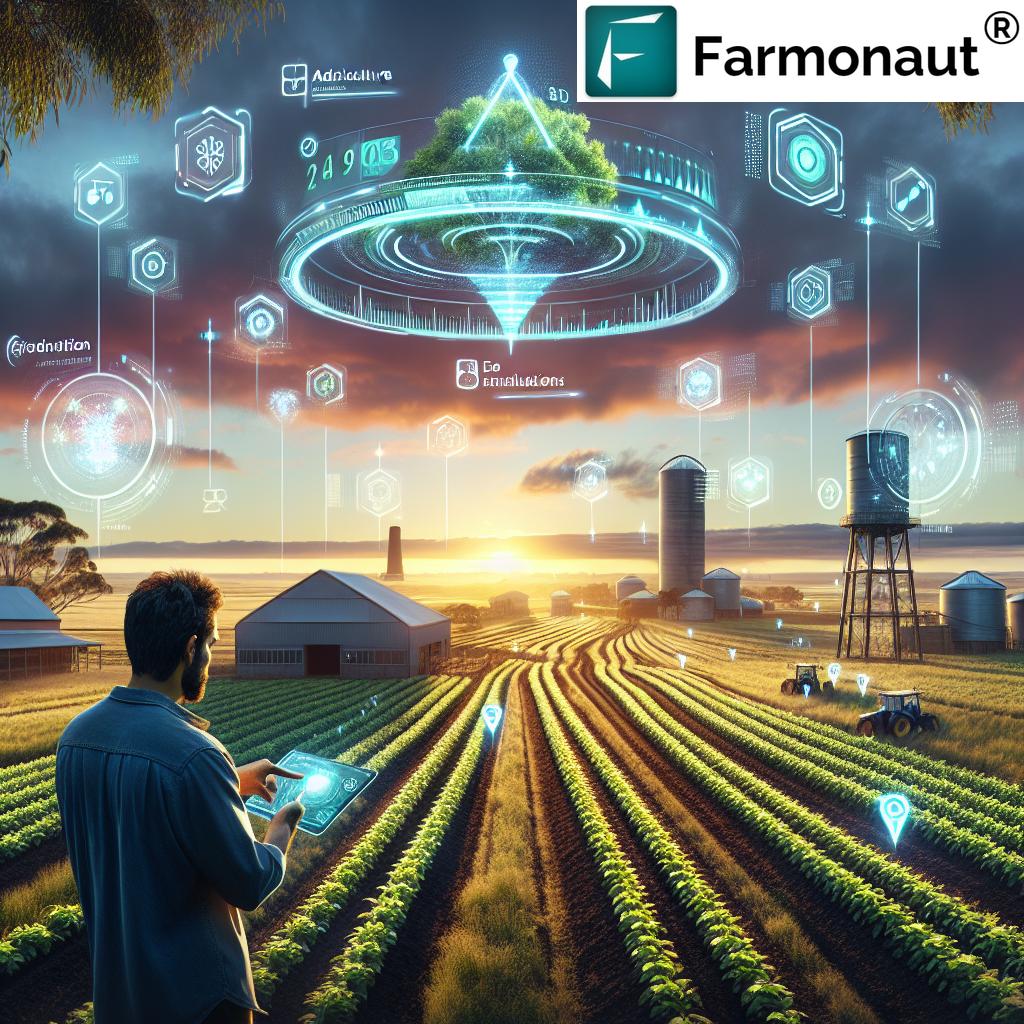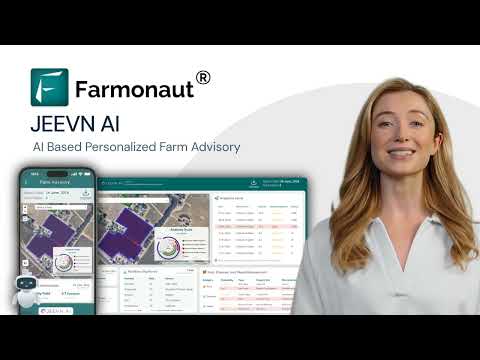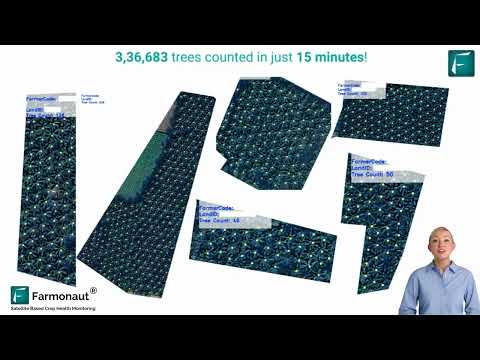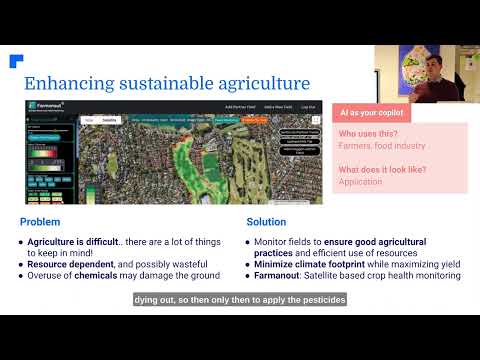Revolutionizing Agriculture: How AI and Remote Sensing Are Transforming Crop Health Monitoring in Australia
“9.9% of Australian study participants used ChatGPT for health inquiries in early 2024, highlighting AI’s growing role in health information.”
In the heart of Sydney and across the vast Australian landscape, a technological revolution is reshaping the way we approach agriculture. As we delve into the world of artificial intelligence (AI) and remote sensing, we’re witnessing a transformation that promises to revolutionize crop health monitoring and management. This blog post explores how these cutting-edge technologies are changing the face of Australian agriculture, offering insights into the benefits, challenges, and future prospects of this exciting field.
The Rise of AI and Remote Sensing in Australian Agriculture
Australia, known for its diverse agricultural sector, is at the forefront of adopting innovative technologies to enhance farm productivity and sustainability. The integration of AI and remote sensing technologies is proving to be a game-changer for farmers, agronomists, and policymakers alike. These advanced tools are enabling more precise, data-driven decision-making processes that were once unimaginable.
Remote sensing, in particular, has emerged as a powerful tool for crop health monitoring. By utilizing satellite imagery and advanced sensors, farmers can now gain unprecedented insights into their fields without setting foot on them. This technology allows for the detection of early signs of crop stress, disease outbreaks, and nutrient deficiencies, enabling timely interventions that can significantly improve yields and reduce resource waste.

AI complements remote sensing by analyzing vast amounts of data collected from satellites, drones, and ground sensors. Machine learning algorithms can identify patterns and trends that might be invisible to the human eye, providing farmers with actionable insights to optimize their crop management strategies.
Key Technologies Driving the Agricultural Revolution
Several key technologies are at the forefront of this agricultural revolution in Australia:
- Satellite Imagery: High-resolution satellite images provide a bird’s-eye view of vast agricultural areas, allowing for large-scale monitoring of crop health and growth patterns.
- Multispectral and Hyperspectral Sensors: These advanced sensors can detect light wavelengths beyond human vision, revealing crucial information about plant health, soil moisture, and nutrient levels.
- Machine Learning and AI Algorithms: Sophisticated algorithms analyze data from various sources to predict crop yields, detect diseases, and recommend optimal resource allocation.
- Internet of Things (IoT) Devices: Connected sensors and devices in the field provide real-time data on soil conditions, weather, and crop status, feeding into AI systems for analysis.
One company at the forefront of this technological revolution is Farmonaut. Their innovative platform integrates satellite-based crop health monitoring with AI-driven advisory systems, offering farmers a comprehensive solution for precision agriculture.
The Impact of AI and Remote Sensing on Crop Health Monitoring
The integration of AI and remote sensing technologies is transforming crop health monitoring in several key ways:
- Early Detection of Crop Stress: Remote sensing can identify signs of plant stress before they become visible to the naked eye, allowing for prompt intervention.
- Precision Resource Management: AI-powered systems can recommend precise amounts of water, fertilizers, and pesticides based on real-time crop needs, reducing waste and environmental impact.
- Disease and Pest Monitoring: Advanced imaging techniques can detect the early stages of disease or pest infestations, enabling targeted treatments and reducing the need for broad-spectrum pesticides.
- Yield Prediction and Optimization: By analyzing historical data and current crop conditions, AI models can accurately predict yields and suggest strategies to optimize production.
These advancements are not only improving crop yields but also contributing to more sustainable farming practices. By optimizing resource use and reducing chemical inputs, AI and remote sensing technologies are helping Australian farmers minimize their environmental footprint while maximizing productivity.
Comparative Analysis: Traditional vs. AI-Assisted Crop Health Monitoring
To better understand the transformative impact of AI and remote sensing on Australian agriculture, let’s examine a comparative analysis of traditional and AI-assisted crop health monitoring methods:
| Monitoring Aspect | Traditional Method | AI/Remote Sensing Method | Efficiency Improvement (%) | Cost Reduction (%) | Environmental Impact |
|---|---|---|---|---|---|
| Disease Detection | Visual inspection | Multispectral imaging + AI analysis | 80% | 60% | Low |
| Yield Prediction | Historical data + manual estimation | Machine learning models + satellite data | 90% | 70% | Low |
| Soil Analysis | Laboratory testing of soil samples | Hyperspectral imaging + AI interpretation | 75% | 50% | Medium |
| Pest Detection | Regular field scouting | Drone imagery + AI pattern recognition | 85% | 65% | Low |
| Irrigation Management | Fixed schedules + manual adjustments | IoT sensors + AI-driven scheduling | 70% | 40% | High |
This table clearly illustrates the significant advantages of AI and remote sensing technologies across various aspects of crop health monitoring. The efficiency improvements and cost reductions are substantial, while the environmental impact is generally lower compared to traditional methods.
Challenges and Considerations
While the benefits of AI and remote sensing in agriculture are clear, there are several challenges and considerations to keep in mind:
- Data Privacy and Security: As more farm data is collected and analyzed, ensuring the privacy and security of this information becomes crucial.
- Technology Adoption: Some farmers may face barriers in adopting these new technologies, including initial costs and the need for technical training.
- Reliability of AI Models: Ensuring the accuracy and reliability of AI predictions across diverse agricultural conditions is an ongoing challenge.
- Integration with Existing Systems: Seamlessly integrating new technologies with traditional farming practices and equipment can be complex.
“AI health tools show higher usage among those with low health literacy and non-English speaking backgrounds, potentially bridging information gaps.”
Addressing these challenges will be crucial for the widespread adoption and success of AI and remote sensing technologies in Australian agriculture.
The Role of Farmonaut in Revolutionizing Australian Agriculture
In the context of this technological revolution, Farmonaut stands out as a pioneering force in agricultural technology. Their platform offers advanced, satellite-based farm management solutions that are accessible via Android, iOS, web/browser apps, and API. Farmonaut’s mission aligns perfectly with the needs of Australian farmers: to make precision agriculture affordable and accessible by integrating innovative technology and data-driven insights into traditional farming practices.
Key features of Farmonaut’s platform include:
- Satellite-Based Crop Health Monitoring: Utilizing multispectral satellite images to provide insights into vegetation health, soil moisture levels, and other critical metrics.
- Jeevn AI Advisory System: An AI-driven personalized farm advisory tool that delivers real-time insights, weather forecasts, and expert crop management strategies.
- Blockchain-Based Product Traceability: Ensuring transparency and security in agricultural supply chains.
- Fleet and Resource Management: Tools for efficient management of agricultural machinery and resources.
- Carbon Footprinting: Helping agribusinesses monitor and reduce their environmental impact.
Farmonaut’s subscription-based model and flexible pricing tiers make their advanced technologies accessible to a wide range of users, from individual farmers to large agribusinesses and government institutions. Their API access also opens up possibilities for integration with other agricultural systems and research initiatives.
For those interested in exploring Farmonaut’s API capabilities, you can find more information at their API page and detailed documentation in their API Developer Docs.
The Future of AI and Remote Sensing in Australian Agriculture
As we look to the future, the potential for AI and remote sensing in Australian agriculture seems boundless. Some exciting prospects include:
- Advanced Predictive Analytics: More sophisticated AI models will be able to predict crop yields, market trends, and climate impacts with even greater accuracy.
- Autonomous Farming Systems: Integration of AI with robotics could lead to fully autonomous farming operations, from planting to harvesting.
- Personalized Crop Varieties: AI-driven genetic analysis could help develop crop varieties tailored to specific Australian microclimates and soil conditions.
- Enhanced Climate Resilience: Advanced modeling techniques will help farmers adapt to changing climate conditions more effectively.
These advancements promise to further increase productivity, sustainability, and resilience in Australian agriculture, positioning the country as a global leader in agri-tech innovation.
Embracing the Digital Agriculture Revolution
The integration of AI and remote sensing technologies in Australian agriculture represents a significant leap forward in how we approach crop health monitoring and management. These technologies offer unprecedented insights, efficiency gains, and environmental benefits that are transforming the agricultural landscape.
As we embrace this digital agriculture revolution, it’s crucial for farmers, policymakers, and technology providers to work together to address challenges and ensure that these innovations benefit all stakeholders in the agricultural ecosystem. Companies like Farmonaut are playing a vital role in making these advanced technologies accessible and practical for farmers of all scales.
By harnessing the power of AI and remote sensing, Australian agriculture is poised to meet the challenges of the 21st century, from feeding a growing population to adapting to climate change. The future of farming is here, and it’s digital, data-driven, and more sustainable than ever before.
Farmonaut Subscriptions
Earn With Farmonaut
Earn 20% recurring commission with Farmonaut’s affiliate program by sharing your promo code and helping farmers save 10%. Onboard 10 Elite farmers monthly to earn a minimum of $148,000 annually—start now and grow your income!
For more information about this exciting opportunity, visit Farmonaut’s Affiliate Program.
Frequently Asked Questions (FAQ)
- What is remote sensing in agriculture?
Remote sensing in agriculture refers to the use of satellite or aerial imagery and other non-contact methods to gather information about crops and soil conditions. It allows farmers to monitor large areas efficiently and detect issues early. - How does AI improve crop health monitoring?
AI analyzes vast amounts of data from various sources, including satellite imagery and ground sensors, to identify patterns and anomalies in crop health. It can predict potential issues, recommend precise interventions, and optimize resource use. - What are the benefits of using AI and remote sensing in agriculture?
Benefits include early detection of crop stress, more efficient resource management, improved yield predictions, reduced environmental impact, and cost savings through targeted interventions. - Are these technologies accessible to small-scale farmers in Australia?
Yes, companies like Farmonaut are making these technologies more accessible through affordable subscription models and user-friendly apps, allowing small-scale farmers to benefit from advanced agricultural technologies. - How does Farmonaut’s platform work?
Farmonaut’s platform uses satellite imagery and AI to provide real-time insights on crop health, soil conditions, and weather patterns. It offers personalized advice through its Jeevn AI system and includes features for resource management and sustainability tracking.
As we conclude this exploration of AI and remote sensing in Australian agriculture, it’s clear that these technologies are not just transforming crop health monitoring but are reshaping the entire agricultural landscape. The integration of advanced tools like those offered by Farmonaut is paving the way for a more efficient, sustainable, and productive farming future. By embracing these innovations, Australian farmers are well-positioned to meet the challenges of tomorrow while leading the global agricultural technology revolution.







